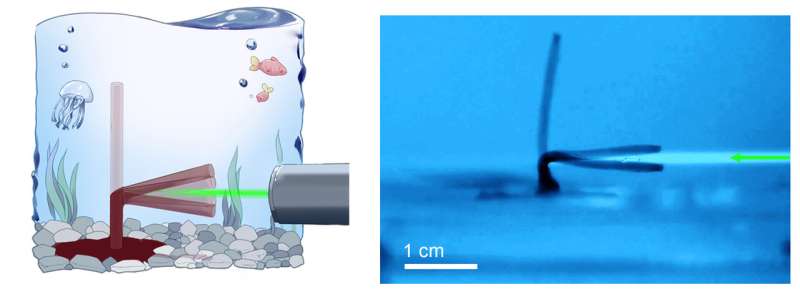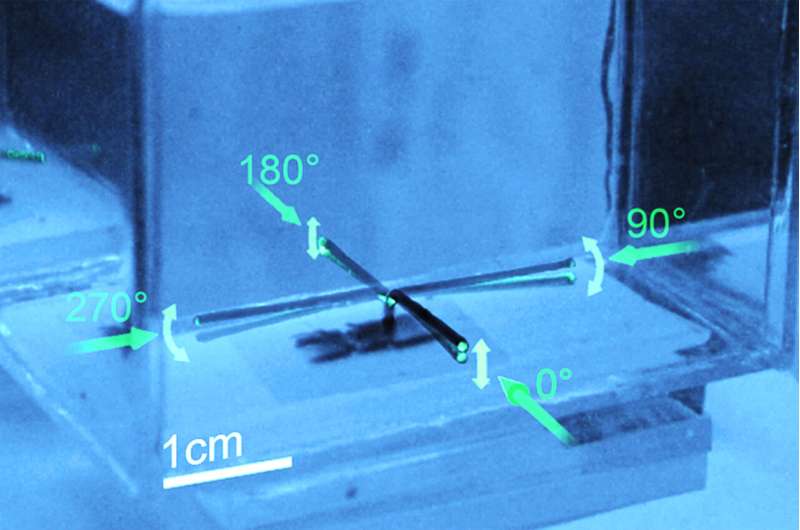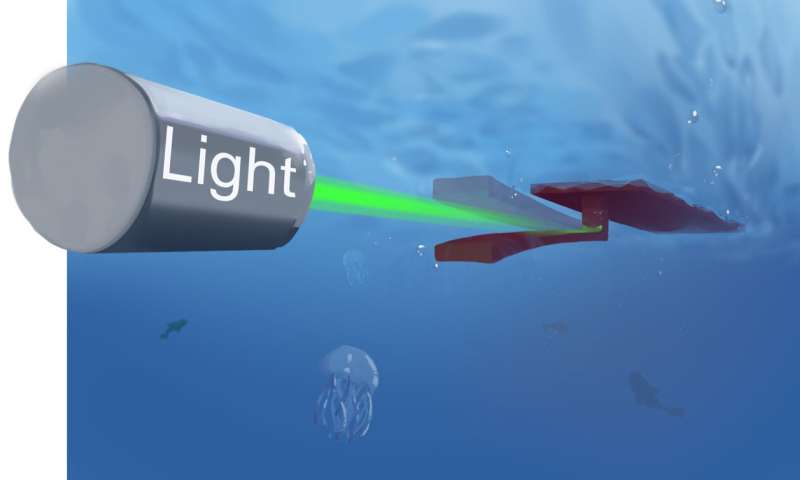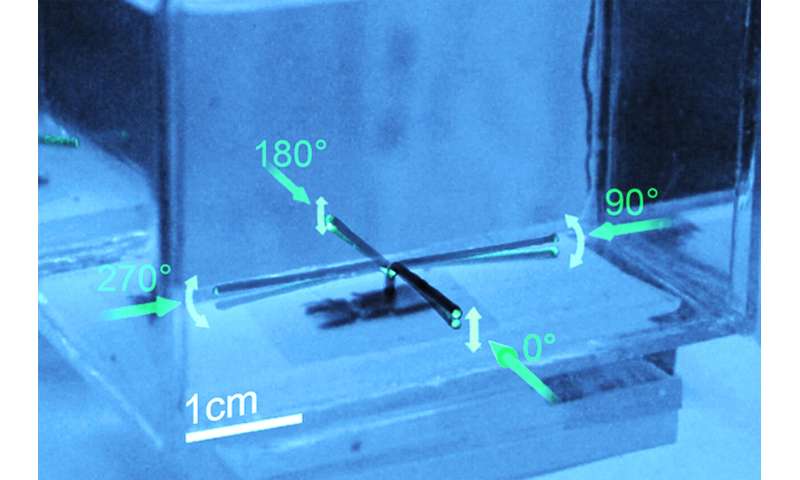September 10, 2019 feature
A soft phototactic swimming robot built using a self-sustained hydrogel oscillator

Researchers at the University of California, Los Angeles (UCLA) and the California NanoSystems Institute in Los Angeles have recently developed a soft swimming robot based on a self-sustained hydrogel oscillator. This robot, presented in a paper published in Science Robotics, operates under constant light input without the need for a battery.
"When I shone light on a soft, fast responsive hydrogel pillar, I observed the pillar started to oscillate around the optical beam," Yusen Zhao, a Ph.D. student involved in the research, said. "It looked very intriguing to me, and I wondered: How can a constant input produce intermittent output? Under what conditions does the oscillation happen? Would it be powerful enough to propel and swim in water, and eventually lead to solar sails? With these questions, I continued systematic studies aiming to achieve these objectives."
Zhao and his colleagues developed a soft oscillator made of a light-responsive soft gel, which is molded into the shape of a pillar or strip. When light hits a spot of this gel pillar, it is automatically absorbed and converted into heat. The locally heated spot on the robot causes it to eject some of its water and shrink in volume, resulting in its tail bending towards the light source.
"After it bends up, the tail itself blocks the light," Zhao explained. "Thus, the shadowed spot instantly cools down and re-swells, which causes the tail to descend again. This process repeats rapidly, resulting in a flapping motion that lasts for as long as light applies."
As the gel pillar is made to be compositionally homogeneous and geometrically symmetric, it is able to respond to light from arbitrary directions, which can cover almost the entire 3-D space. The oscillator features near-infinite degrees of freedom, an important advantage for robotics.
The researchers evaluated their swimming robot with its body floating on the surface of the water and its tail below the waterline to ascertain the effectiveness of its design. They found that as light shone on the robot's tail, it oscillated up and down, ultimately powering the robot to swim away from the light. This unique feature of moving following the direction of a light source mimicked the phototaxis behaviors of many living animals such as plankton and moths, providing a useful means of navigation and maneuvering via remote control.
"The beauty of the soft robot is the simplicity of its design," Ximin He, Zhao's supervisor on the study, told TechXplore. "The entire robot is made of a single homogenous hydrogel, which extremely simplifies the fabrication and makes it low-cost."

To fabricate the self-sustained hydrogel oscillator and make it into a desired shape, the researchers injected the precursor solution into a predefined mold, UV-cured the gel, and removed it from the mold. As the principle behind the realization of the robot is very general and broadly applicable, the oscillator can be built from many materials.
"It is exciting to have discovered a new universal principle of generating oscillatory motion with environmental energy source," He said. "With this, we realized that constant environmental stimuli, such as light, can generate powerful oscillation with such a simple material to propel and move in water, guided by the light directionally. This provides a general means of harvesting and converting environmental energy to kinetic energy and many other forms of energy to perform meaningful work."
In their study, Zhao, He and their colleagues unveiled a new methodology to generate oscillatory motions using naturally occurring sources of energy. Researchers who adopt this methodology to build oscillators can choose from a broad range of stimuli-responsive materials, according to the type of energy they wish to harvest.
-

Credit: Zhao et al. -

Credit: Zhao et al.
The swimming robot created by the researchers is powered by photo-oscillation, and its movements are guided by constant light; thus, it is untethered, battery-free and intelligent. It is one of the first entirely soft robots ever developed that is also lightweight, low-cost and easily deployable.
"We now plan to further optimize the materials to be able to oscillate under wider conditions, such as temperature, wavelengths of light, etc.," Zhao said. "We are also looking for more applications, such as signal sensing, energy harvesting, and other robotic motions."
More information: Yusen Zhao et al. Soft phototactic swimmer based on self-sustained hydrogel oscillator, Science Robotics (2019). DOI: 10.1126/scirobotics.aax7112
© 2019 Science X Network


















